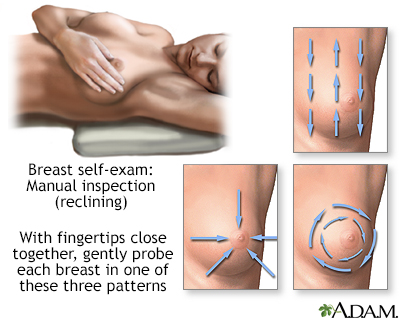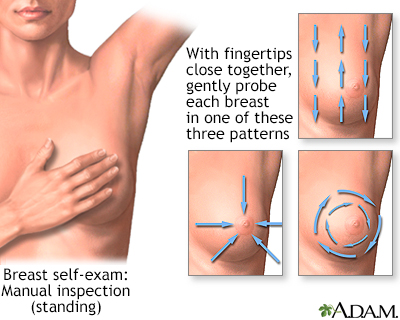Breast self-exam
A breast self-exam is something a woman does at home to look for changes or problems in her breast tissue. Many women feel that doing this is important to their health.
However, experts do not agree about the benefits of breast self-exams in finding breast cancer or saving lives. Talk to your health care provider about whether breast self-exams are right for you.
Breast cancer
Breast cancer is cancer that starts in the tissues of the breast. There are two main types of breast cancer:Ductal carcinoma starts in the tubes (du...

Breast self-exam - Animation
If you're a woman, your doctor or gynecologist may have recommended that you examine your breasts every month to check for lumps. You might be wondering, why do I need to do a breast self-exam? Or, you might ask, how do I examine my breasts, and what exactly am I looking for? Well, let's talk about why, and how to examine your breasts. Why examine your breasts? Well, for one thing, it helps you get an idea of how they normally feel. Then if there's ever a problem, you'll be familiar enough with your breasts to spot it. For example, a lump on your breast could be a sign of breast cancer. Finding that lump could allow you to get checked out with a mammogram earlier than you might have done if you didn't do breast self exams. But, this is a two edged sword. Many expert groups no longer recommend routine breast self examination because the consequences of over treatment of benign or normal lumps may outweigh the benefits of early detection. Lumps lead to extra mammograms, which often lead to biopsies, and the biopsies turn out to be benign, or normal, in more than 90% of cases. But, not always. Some expert groups simply recommend breast self awareness. Ultimately, the choice is yours. If you are going to do breast self exam, the best day to do a self exam is about 3 to 5 days after your period ends. Your breasts are naturally less lumpy right after your period, so there's less of a chance that you'll mistake a normal bump for an abnormal growth. If you've already gone through menopause and your periods have stopped, just do your exam on the same day every month. Mark it on your calendar so you won't forget. To do the exam, lie on your back, as it's easier to feel any lumps or changes when you're lying down. First, put your right hand behind your head. Then, using the middle fingers on your left hand, gently but firmly press down, circling your entire breast. Make sure you cover the whole right breast. Squeeze your nipple gently. See if any fluid comes out. Now, sit up, and feel around your armpit. When you're done with the right breast, repeat the whole check on the left side. Next, stand in front of a mirror. With your arms down at your sides, look at both breasts. Check the shape of each breast. Look for any changes in the skin, like dimpling or puckering. Also see if your nipples now turn inward. Now, do the exact same check again with your arms over your head. After you've done a few breast self-exams, you'll become familiar with the look and shape of your breasts. At each exam, you're looking for anything different, like new bumps, changes in the texture of your skin, or discharge from your nipple. If you do notice that something has changed, don't panic, it could mean many different things. But, call your doctor as soon as you can so you can find out what's caused the change, and, if necessary, get it treated.
Information
The best time to do a monthly breast self-exam is about 3 to 5 days after your period starts. Do it at the same time every month. Your breasts are not as tender or lumpy at this time in your monthly cycle.
If you have gone through menopause, do your exam on the same day every month.
Menopause
Menopause is the time in a woman's life when her periods (menstruation) stop. Most often, it is a natural, normal body change that occurs between ag...

Begin by lying on your back. It is easier to examine all breast tissue if you are lying down.
- Place your right hand behind your head. With the middle fingers of your left hand, gently yet firmly press down using small motions to examine the entire right breast.
- Next, sit or stand. Feel your armpit, because breast tissue goes into that area.
- Gently squeeze the nipple, checking for discharge. Repeat the process on the left breast.
- Use one of the patterns shown in the diagram to make sure that you are covering all of the breast tissue.

Breast self-exam
Monthly breast self-exams should always include a visual inspection, with and without a mirror, to note any changes in contour or texture, and manual inspection in standing and reclining positions to note any unusual lumps or thicknesses.
Next, stand in front of a mirror with your arms by your side.
- Look at your breasts directly and in the mirror. Look for changes in skin texture, such as dimpling, puckering, indentations, or skin that looks like an orange peel.
- Also note the shape and outline of each breast.
- Check to see if the nipple turns inward.
Do the same with your arms raised above your head.
Your goal is to get used to the feel of your breasts. This will help you to find anything new or different. If you do, contact your provider right away.
Reviewed By
Linda J. Vorvick, MD, Clinical Professor Emeritus, Department of Family Medicine, UW Medicine, School of Medicine, University of Washington, Seattle, WA. Also reviewed by David C. Dugdale, MD, Medical Director, Brenda Conaway, Editorial Director, and the A.D.A.M. Editorial team.
American Cancer Society website. American Cancer Society recommendations for the early detection of breast cancer. www.cancer.org/cancer/types/breast-cancer/screening-tests-and-early-detection/american-cancer-society-recommendations-for-the-early-detection-of-breast-cancer.html. Updated December 19, 2023. Accessed December 30, 2024.
Mallory MA, Golshan M. Clinical encounter with the patient. In: Klimberg VS, Gradishar WJ, Bland KI, Korourian S, White J, Copeland EM, eds. Bland and Copeland's The Breast. 6th ed. Philadelphia, PA: Elsevier; 2024:chap 11.
National Cancer Institute website. Breast cancer screening (PDQ) - health professional version. www.cancer.gov/types/breast/hp/breast-screening-pdq. Updated April 10, 2025. Accessed June 3, 2025.
Swartz MH, Nentin FG. The breast. In: Swartz MH, ed. Textbook of Physical Diagnosis: History and Examination. 8th ed. Philadelphia, PA: Elsevier; 2021:chap 16.
US Preventive Services Task Force website. Final recommendation statement. Breast cancer: screening. www.uspreventiveservicestaskforce.org/uspstf/recommendation/breast-cancer-screening. Updated April 30, 2024. Accessed January 6, 2025.




 All rights reserved.
All rights reserved.